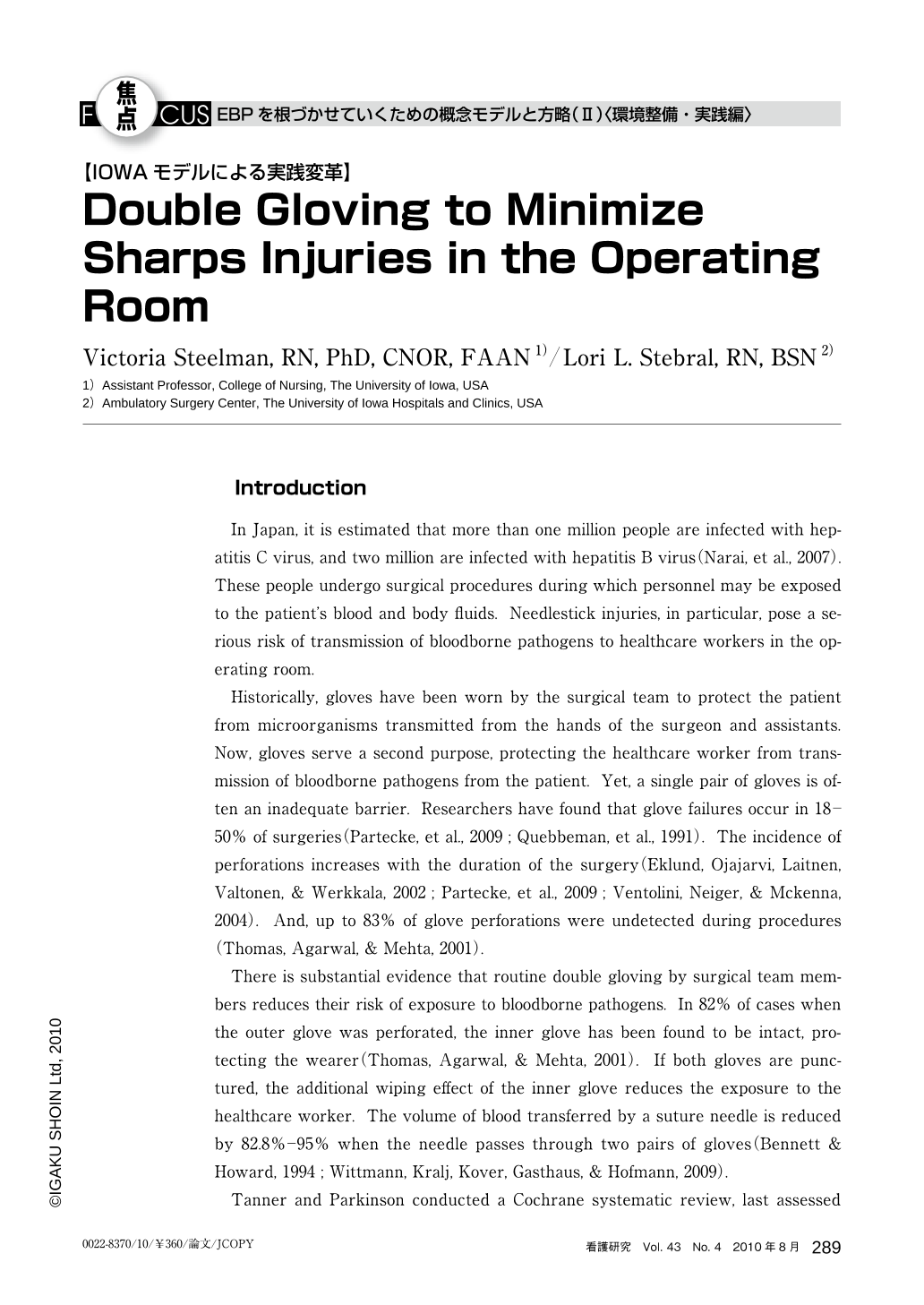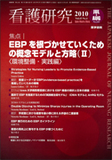Japanese
English
- 有料閲覧
- Abstract 文献概要
- 1ページ目 Look Inside
- 参考文献 Reference
Introduction
In Japan, it is estimated that more than one million people are infected with hepatitis C virus, and two million are infected with hepatitis B virus (Narai, et al., 2007). These people undergo surgical procedures during which personnel may be exposed to the patient's blood and body fluids. Needlestick injuries, in particular, pose a serious risk of transmission of bloodborne pathogens to healthcare workers in the operating room.
Historically, gloves have been worn by the surgical team to protect the patient from microorganisms transmitted from the hands of the surgeon and assistants. Now, gloves serve a second purpose, protecting the healthcare worker from transmission of bloodborne pathogens from the patient. Yet, a single pair of gloves is often an inadequate barrier. Researchers have found that glove failures occur in 18-50% of surgeries (Partecke, et al., 2009 ; Quebbeman, et al., 1991). The incidence of perforations increases with the duration of the surgery (Eklund, Ojajarvi, Laitnen, Valtonen, & Werkkala, 2002 ; Partecke, et al., 2009 ; Ventolini, Neiger, & Mckenna, 2004). And, up to 83% of glove perforations were undetected during procedures (Thomas, Agarwal, & Mehta, 2001).
There is substantial evidence that routine double gloving by surgical team members reduces their risk of exposure to bloodborne pathogens. In 82% of cases when the outer glove was perforated, the inner glove has been found to be intact, protecting the wearer (Thomas, Agarwal, & Mehta, 2001). If both gloves are punctured, the additional wiping effect of the inner glove reduces the exposure to the healthcare worker. The volume of blood transferred by a suture needle is reduced by 82.8%-95% when the needle passes through two pairs of gloves (Bennett & Howard, 1994 ; Wittmann, Kralj, Kover, Gasthaus, & Hofmann, 2009).
Tanner and Parkinson conducted a Cochrane systematic review, last assessed and found up to date in 2009, to address the value of double gloving (Tanner & Parkinson, 2006). The review critiqued 18 clinical trails, with nine randomized clinical trials found acceptable for inclusion. Results of these nine studies were included in a meta-analyses, demonstrating that :
・There is no difference in rates of perforations between single gloves compared with outer gloves when two pairs of gloves are worn (p=0.3) ;
・Perforations to the glove closest to the skin are reduced when wearing double gloves compared with single gloves (p<0.00001) ;
・Significantly more outer glove perforations are detected when using a colored underglove, compared with two pairs of standard latex gloves (p=0.002) (Tanner & Parkinson, 2006).
This high level of evidence supports the practice of double gloving for protection of surgical team members from exposures resulting from glove perforations. It also demonstrates that wearing a colored underglove enhances detection of glove failures during use. Detection rates of perforations were 78-90% when wearing a colored underglove, compared to 21-42% with a single glove (Tanner & Parkinson, 2006).
The Centers for Disease Control and Prevention supports the practice of double-gloving (Mangram, Horan, Pearson, Silver, & Jarvis, 1999). Likewise, The American Academy of Orthopaedic Surgeons, the American Association of Orthopaedic Surgeons, and the Association of periOperative Registered Nurses (AORN) recommend double gloving during invasive procedures (AAOS, 2002 ; Anonymous, 2009).
Introduction
In Japan, it is estimated that more than one million people are infected with hepatitis C virus, and two million are infected with hepatitis B virus (Narai, et al., 2007). These people undergo surgical procedures during which personnel may be exposed to the patient's blood and body fluids. Needlestick injuries, in particular, pose a serious risk of transmission of bloodborne pathogens to healthcare workers in the operating room.
Historically, gloves have been worn by the surgical team to protect the patient from microorganisms transmitted from the hands of the surgeon and assistants. Now, gloves serve a second purpose, protecting the healthcare worker from transmission of bloodborne pathogens from the patient. Yet, a single pair of gloves is often an inadequate barrier. Researchers have found that glove failures occur in 18-50% of surgeries (Partecke, et al., 2009 ; Quebbeman, et al., 1991). The incidence of perforations increases with the duration of the surgery (Eklund, Ojajarvi, Laitnen, Valtonen, & Werkkala, 2002 ; Partecke, et al., 2009 ; Ventolini, Neiger, & Mckenna, 2004). And, up to 83% of glove perforations were undetected during procedures (Thomas, Agarwal, & Mehta, 2001).
There is substantial evidence that routine double gloving by surgical team members reduces their risk of exposure to bloodborne pathogens. In 82% of cases when the outer glove was perforated, the inner glove has been found to be intact, protecting the wearer (Thomas, Agarwal, & Mehta, 2001). If both gloves are punctured, the additional wiping effect of the inner glove reduces the exposure to the healthcare worker. The volume of blood transferred by a suture needle is reduced by 82.8%-95% when the needle passes through two pairs of gloves (Bennett & Howard, 1994 ; Wittmann, Kralj, Kover, Gasthaus, & Hofmann, 2009).
Tanner and Parkinson conducted a Cochrane systematic review, last assessed and found up to date in 2009, to address the value of double gloving (Tanner & Parkinson, 2006). The review critiqued 18 clinical trails, with nine randomized clinical trials found acceptable for inclusion. Results of these nine studies were included in a meta-analyses, demonstrating that :
・There is no difference in rates of perforations between single gloves compared with outer gloves when two pairs of gloves are worn (p=0.3) ;
・Perforations to the glove closest to the skin are reduced when wearing double gloves compared with single gloves (p<0.00001) ;
・Significantly more outer glove perforations are detected when using a colored underglove, compared with two pairs of standard latex gloves (p=0.002) (Tanner & Parkinson, 2006).
This high level of evidence supports the practice of double gloving for protection of surgical team members from exposures resulting from glove perforations. It also demonstrates that wearing a colored underglove enhances detection of glove failures during use. Detection rates of perforations were 78-90% when wearing a colored underglove, compared to 21-42% with a single glove (Tanner & Parkinson, 2006).
The Centers for Disease Control and Prevention supports the practice of double-gloving (Mangram, Horan, Pearson, Silver, & Jarvis, 1999). Likewise, The American Academy of Orthopaedic Surgeons, the American Association of Orthopaedic Surgeons, and the Association of periOperative Registered Nurses (AORN) recommend double gloving during invasive procedures (AAOS, 2002 ; Anonymous, 2009).

Copyright © 2010, Igaku-Shoin Ltd. All rights reserved.


